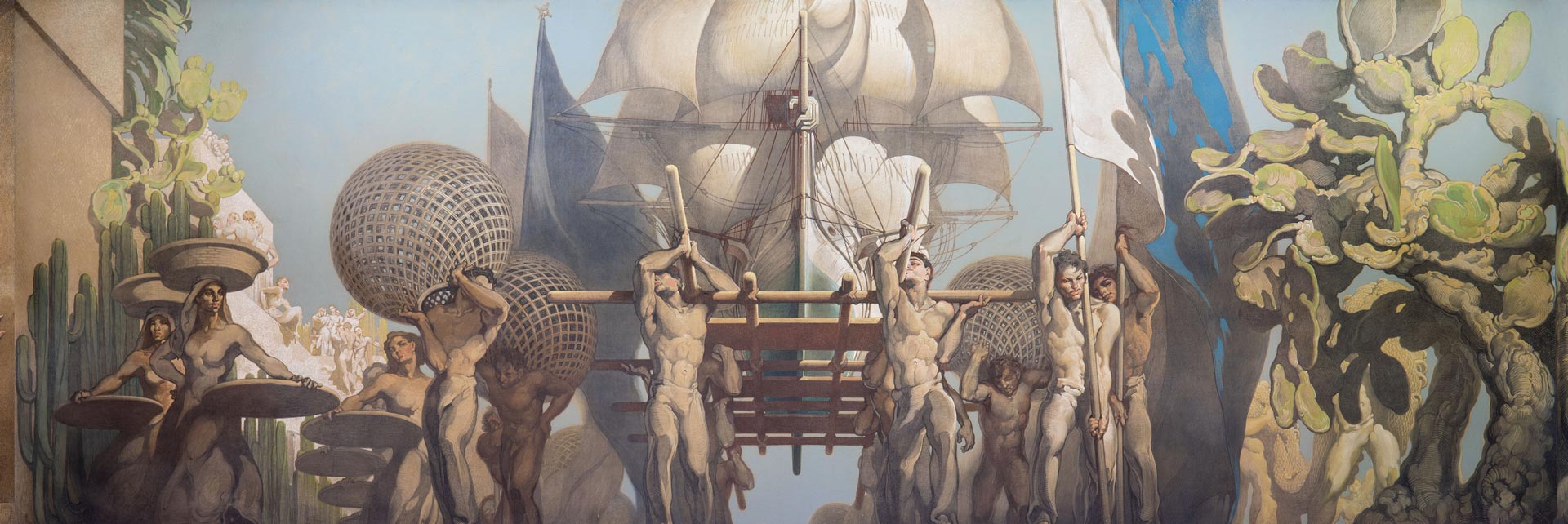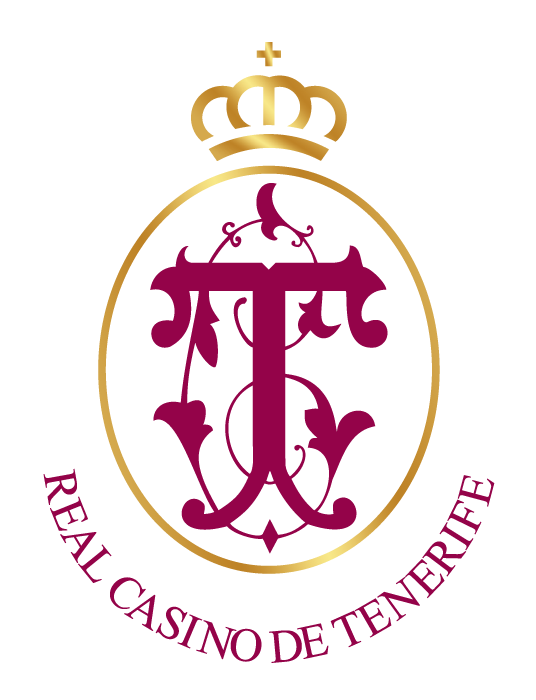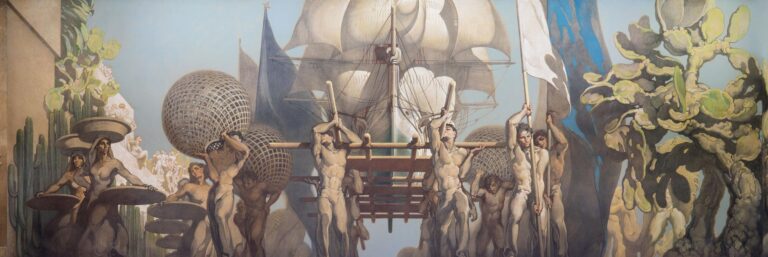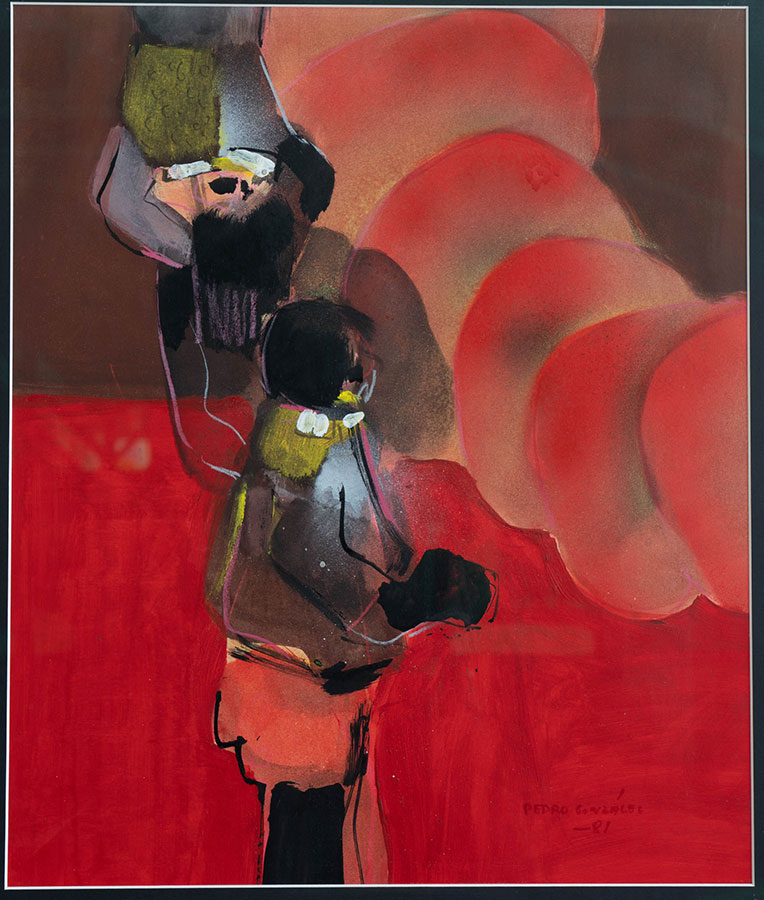
- Type of work: Mural painting
- Technique: Oil on canvas
- Approximate dimensions: The central panel: 400 x 1000 cm. The sides: 400 x 330 cm
- Theme: Allegorical
- Title: Allegory of the Sea
- Author: Néstor Martín Fernández de la Torre (1887-1938)
- Chronology or Year: 1935
- Historical-artistic analysis:
Style: Exaltation of the Canarian world following symbolist and aesthetic guidelines typical of modernism.
Description: The set formed by two great themes, El Mar en el testero sur and La Tierra en el testero norte, is all of it a song of exaltation in which the Canarian is glorified through the work of the island men and women. Both are conceived as triptychs distributed in three scenes that develop in compositional and thematic continuity, where with the elements of nature, previously studied in detail, as in the case of flora, he recreates a mythical and allegorical world of muscular men and women, of portentous anatomy. With a compositional complexity full of foreshortenings and a certain baroque style in the perspectives and in the dynamic tension achieved with a perfect mastery of drawing, mainly supported by the strength of the curved line, the sobriety and restraint of the color stands out. In both panels, distributed respectively in three scenes, the most festive content of the theme occupies the central part, presenting on the sides the images more related to work. In the painting dedicated to the sea, the central scene is a sailor’s parade of muscular men, like demigods, carrying a large boat, the central axis that drives the composition, accompanied by those who carry the buoys and the fisherwomen with baskets and trays with the fruits of the catch. On both sides are represented the works related to water, the salting of fish on the left and watering on the right that together with the row of earthenware jars located between white walls and lush philodendrons form a set of great plastic effect, which contrasts with the flora of cacti and cactus on the left side. In the panel La Tierra, again a pilgrimage scene occupies the central part, with peasant women riding camels led by peasants who cover their backs with the typical Esperanza blanket. The representation of bananas and men carrying baskets with tomatoes in the side scenes has been interpreted as a tribute to the new products that sustain the island’s agricultural economy, as opposed to the cycle of the cochineal that has already been overcome, to which the tuneras allude. The contrast between leisure and work is accompanied here by a greater attention given to the flora of cardons and piteras or the magnificent specimen of the dragon tree, symbol of the region, but also of fertility and long life. In this sense, the symbolic content of what is represented is very rich and varied; it has been identified as the contrast between north and south, or between the new and the old, also hiding a rich content of meanings in the symbolic language that each plant could contain. As for the treatment of the human being, he stands out for his beauty and ambiguity, with miguelanguelescos bodies in their proportions that transpire sensuality and island ethnicity, in a mythical and idyllic atmosphere.
Date of reception: On April 1, 1935, the act of reception is signed.
Observations: This work was part of the decoration of the building, commissioned to Miguel Martín Fernández de la Torre by the Casino by contract dated November 23, 1933, whose sketches were approved by the Board of Directors before the signing of the contract. In the breakdown of the overall budget foreseen for the entire ornamentation of the building, 50,000 pesetas are quoted for these paintings, with a completion period of 8 months from that date. Nestor’s participation in the design and organization of the Canarian procession in Madrid for the parade commemorating the anniversary of the Republic delayed the completion of these paintings. The work was carried out at the Gabinete Literario in Las Palmas de Gran Canaria, with the collaboration of selected students from the Luján Pérez School, specifically in the transfer to canvas of gridded copies of the drawings previously traced by the artist, who made the appropriate retouches and the application of color. The artist himself placed the canvases, rectifying the measurements of the canvases and adding some lateral strips due to an error in the dimensions.
About the author: Néstor Martín – Fernández de la Torre (Las Palmas de Gran Canaria 1887- 1938), the most outstanding symbolist and modernist painter born in the Canary Islands, began his training as a disciple of Eliseo Meifrén in his native city, In 1902 the City Council granted him a scholarship to continue his studies in Madrid under the tutelage of Rafael Hidalgo de Caviedes and the great masters of the Prado Museum. His contact with painters such as Romero de Torres and Zuloaga, members of the café Levante, a meeting where he was introduced by his first teacher, was also very fruitful. He broadened his knowledge by visiting London in 1904, where he studied mainly Whistler and the Pre-Raphaelite painters, and the following year Paris, a city to which he became closely linked by joining one of its Masonic lodges. After two years of apprenticeship, in 1907 he established his studio in Barcelona and, through the Café Continental gathering, he became acquainted with the cultural world of the time, Rusiñol, Eugenio d’Ors, José M a Sert or Albéniz, among others. The success obtained with his decorative portraits in his first individual exhibition in the Equestrian Circle of that city (1908) gave him important commissions, such as the decoration of the Tibidabo Society, initiating his facet as a muralist in the decoration of his panels, exhibited in the Sala Parés in 1909. The Catalan period, which lasted until 1913, corresponds to the first stage of maturity of the painter within the symbolist style, with a first period of English influence, characterized by a decadentism with references to Rossetti or Burne Jones, and a second period of more clearly symbolist influence due to his entry into the Masonic world, with more heterogeneous continental contacts ranging from Klimt to Moreau, references to Renaissance artists, especially Leonardo da Vinci, and the aesthetics instilled in the Rosa Cruz salons. In this symbolism, born as a reaction to academic historicism or costumbrismo, with support in literature and music, based on the interpretation of myths or classical allegories along with the creation of new symbols, incorporates the modernist curvilinear rhythm and a provocative concept of sexuality, with interest in the androgynous nude, built with broad brushstrokes and impasto, influenced by Velázquez recovered, with a decorative sense and a great mastery of drawing. The second symbolist stage, from 1913 to 1928, was occupied by a single theme: the Poem of the Elements, the most ambitious project of Spanish symbolism, whose content is inspired by Freemasonry, which in turn takes it from the pre-Socratic thought of Empedocles, who unified the theories of water, together with air and fire, reflected in the Masonic opera The Magic Flute. To the element of water in the Poem of the Atlantic he dedicated eight frames, the Poem of the Earth also consists of eight, and probably he would have thought of the same structure for the poems of Fire and Air. He only finished Poema del Mar, which was exhibited in 1924 at the Palacio de La Biblioteca y Museos Nacionales in Madrid, the city where he took up residence in 1920, although again in 1928 he moved his studio to Paris. In this third stage of his production (1928 – 1938) his thematic series and scenographies stand out. 1929 is the year of his great scenographic performance in the opera Triana by Albéniz, and in Salomé by Strauss, making the following year the designs for the soprano María Kousnezof in Don Giovanni, those of Carmen and Manon.He had already made his work known in 1916 at the International Fine Arts Exhibition in Panama, at the Witcomb Gallery in Buenos Aires (1918 and 1930) and at the Carnegie Institute in Pittsburg (USA) (1923 and 1926). This work as a set designer continued on the islands after his definitive return to the Canary Islands in 1934, with the set design for the Caballería rusticana for the Pérez Galdós theater, whose decoration he had done in 1928, the set design for La verbena de la paloma and Una noche romántica. His link with this theater led him to revive the Fiesta Pascual in 1938. His curiosity open to all artistic manifestations led him to approach multiple facets of art, such as the realization of posters, illustration of books and magazines, for example The Roses of Hercules by Tomás Morales, jewelry design, stained glass, ceramics and even fabrics. His work was also very important in the recovery of the popular manifestations of the Canary Islands, focused on creating a policy of attracting tourism, through the promotion of ethnographic values, both in architecture, landscape and flora, as well as in folk dances and festivities and crafts, especially materialized in projects such as the Pueblo Canario, the construction of the Santa Catalina hotel in Canarian style or the urbanization of Las Canteras beach. His early death in February 1938 cut short a life impregnated by art.
Bibliography:
Archives of the Casino de Tenerife Minutes J.D. March 3, 1994, p.122
Valeriano WEYLER: The small history of a great casino (The one in Santa Cruz de Tenerife). Santa Cruz de Tenerife, 1964.
Agustín GUIMERÁ RAVINA, Alberto DARIAS PRÍNCIPE: El Casino de Tenerife 1840 – 1990, Santa Cruz de Tenerife, 1992.
Pedro ALMEIDA CABRERA: Néstor Martín Fernández de la Torre. Vice-Ministry of Culture and Sports of the Government of the Canary Islands. Santa Cruz de Tenerife, 1991.





